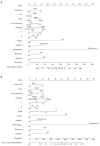Development and validation of nomograms to predict early death in non-small cell lung cancer patients with brain metastasis: a retrospective study in the SEER database
- PMID: 37033346
- PMCID: PMC10080322
- DOI: 10.21037/tcr-22-2323
Development and validation of nomograms to predict early death in non-small cell lung cancer patients with brain metastasis: a retrospective study in the SEER database
Abstract
Background: Throughout the course of non-small cell lung cancer (NSCLC), a lot of patients would develop brain metastasis (BM) associated with the poor prognosis and high rate of mortality. However, there have been few models to predict early death (ED) from NSCLC patients with BM. We aimed to develop nomograms to predict ED in NSCLC patients with BM.
Methods: The NSCLC patients with BM between 2010 and 2015 were selected from the Surveillance, Epidemiology, and End Result (SEER) database. Our inclusion criteria were as follows: (I) patients were pathologically diagnosed as NSCLC; (II) patients who suffered from BM. The patients were randomly divided into 2 cohorts at the ratio of 7:3, for training and validation cohorts, respectively. The univariate and multivariate logistic regression methods were managed to identify risk factors for ED in NSCLC patients with BM. Two nomograms were established and validated by calibration curves, receiver operating characteristic (ROC) curves, and decision curve analysis (DCA). The follow-up data included survival months, causes of death, vital status. Death that occurred within 3 months of initial diagnosis is defined as ED and the endpoints were all-cause ED and cancer-specific ED.
Results: A total of 4,920 NSCLC patients with BM were included and randomly divided into 2 cohorts (7:3), including the training (n=3,444) and validation (n=1,476) cohorts. The independent prognostic factors for all-cause ED and cancer-specific ED included age, sex, race, tumor size, histology, T stage, N stage, grade, surgical operation, radiotherapy, chemotherapy, bone metastasis, and liver metastasis. All these variables were used to establish the nomograms. In the nomograms of all-cause and cancer-specific ED, the areas under the ROC curves were 0.813 (95% CI: 0.799-0.837) and 0.808 (95% CI: 0.791-0.830) for the training dataset as well as 0.835 (95% CI: 0.805-0.862) and 0.824 (95% CI: 0.790-0.849) for the validation dataset, respectively. Besides, the calibration curves proved that the predicted ED was consistent with the actual value. DCA suggested a good clinical application.
Conclusions: The nomograms can be used to predict the specific probability of a patient's death, which aids in treatment decisions and focused care, as well as in physician-patient communication.
Keywords: Non-small cell lung cancer (NSCLC); Surveillance, Epidemiology, and End Result (SEER) database; brain metastasis (BM); early death (ED); nomogram.
2023 Translational Cancer Research. All rights reserved.
Conflict of interest statement
Conflicts of Interest: All authors have completed the ICMJE uniform disclosure form (available at https://tcr.amegroups.com/article/view/10.21037/tcr-22-2323/coif). The authors have no conflicts of interest to declare.
Figures





Similar articles
-
Construction and Validation of Two Novel Nomograms for Predicting the Overall Survival and Cancer-Specific Survival of NSCLC Patients with Bone Metastasis.Int J Gen Med. 2021 Dec 2;14:9261-9272. doi: 10.2147/IJGM.S342596. eCollection 2021. Int J Gen Med. 2021. PMID: 34880665 Free PMC article.
-
The incidence, risk factors and predictive nomograms for early death of lung cancer with synchronous brain metastasis: a retrospective study in the SEER database.BMC Cancer. 2021 Jul 16;21(1):825. doi: 10.1186/s12885-021-08490-4. BMC Cancer. 2021. PMID: 34271858 Free PMC article.
-
Diagnostic and prognostic nomograms for bone metastasis in hepatocellular carcinoma.BMC Cancer. 2020 Jun 1;20(1):494. doi: 10.1186/s12885-020-06995-y. BMC Cancer. 2020. PMID: 32487048 Free PMC article.
-
Construction and validation of prognostic nomograms for elderly patients with metastatic non-small cell lung cancer.Clin Respir J. 2022 May;16(5):380-393. doi: 10.1111/crj.13491. Epub 2022 May 5. Clin Respir J. 2022. PMID: 35514033 Free PMC article. Clinical Trial.
-
Analysis of prognostic factors of metastatic endometrial cancer based on surveillance, epidemiology, and end results database.Front Surg. 2023 Jan 6;9:1001791. doi: 10.3389/fsurg.2022.1001791. eCollection 2022. Front Surg. 2023. PMID: 36684133 Free PMC article. Review.
Cited by
-
Assessing the predictive value of time-in-range level for the risk of postoperative infection in patients with type 2 diabetes: a cohort study.Front Endocrinol (Lausanne). 2025 Apr 15;16:1539039. doi: 10.3389/fendo.2025.1539039. eCollection 2025. Front Endocrinol (Lausanne). 2025. PMID: 40303640 Free PMC article.
-
Development and validation of a prognostic nomogram for patients with malignant peritoneal mesothelioma.Front Oncol. 2025 Feb 28;15:1480197. doi: 10.3389/fonc.2025.1480197. eCollection 2025. Front Oncol. 2025. PMID: 40094014 Free PMC article.
-
Development and validation of a nomogram for predicting the overall survival in non-small cell lung cancer patients with liver metastasis.Transl Cancer Res. 2023 Nov 30;12(11):3061-3073. doi: 10.21037/tcr-23-899. Epub 2023 Oct 26. Transl Cancer Res. 2023. PMID: 38130305 Free PMC article.
References
-
- Zindler JD, Jochems A, Lagerwaard FJ, et al. Individualized early death and long-term survival prediction after stereotactic radiosurgery for brain metastases of non-small cell lung cancer: Two externally validated nomograms. Radiother Oncol 2017;123:189-94. 10.1016/j.radonc.2017.02.006 - DOI - PubMed
LinkOut - more resources
Full Text Sources
